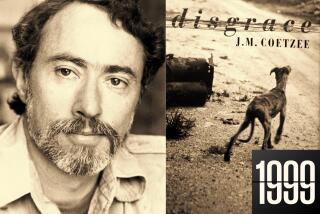To be in the presence of a giant
I came to Los Angeles because of Otis Chandler.
It wasn’t a difficult decision, although there was nothing about L.A. I truly liked. Not the weather nor the city’s drab homogeneity.
This was a fairly lusterless place 35 years ago, but there was one shining beacon that brought many of us south or west, from places like Oakland and Kansas City and New Jersey.
That was Otis.
He was a giant among serfs in the newspaper publishing world, emerging on the horizon at a time when Western journalism didn’t seem to be going anywhere.
We were trapped in a time warp that locked us into a style that was rapidly losing its appeal. Old-time journalism seemed quaintly slow and awkward in the dawning age of television.
I began hearing about the Chandlers and the L.A. Times when I entered newspapering in the 1950s. Former L.A. City Councilman and state Assemblyman William G. Bonelli had written a book called “Billion Dollar Blackjack” that accused The Times of everything from union busting to race baiting. He left the country a step ahead of a grand jury indictment on charges of corruption while a member of the State Board of Equalization and died in Mexico.
Because of the book, and before Bonelli was indicted, I wondered why anyone would want to work for the kind of newspaper he described. But then along came Otis, the surfing, shot-putting, car-racing guy they called Big Oats. He marched out of Stanford University as an athlete and an idealist, honed by professors who knew what his future might be and worked to help build it.
They envisioned a newspaper publisher of special qualities. And they got it.
We began hearing about a different kind of L.A. Times in the 1960s, one that Otis was transforming into a world-class operation. He became its publisher at the start of the decade, and those who were lured to the City of Angels began calling it a writer’s heaven, where budget and space limitations weren’t barriers to getting a story and telling it the way it ought to be told.
He informed the world that he wanted to create a New York Times of the West, in terms of size and quality. His goal was clear: to build from the disrespect of the past, and to make us all forget it ever existed.
My life as a left-of-center columnist at the Oakland Tribune was beginning to fall apart under the strident, right-wing leadership of William Fife Knowland, who had given up a seat in the U.S. Senate in a failed bid for the California governorship. The Knowlands owned the Trib, and WFK took over as publisher. I began looking around.
The timing was perfect.
It was 1972 and Otis had already transformed The Times into a newspaper to match his stature. Good friends Bill Boyarsky and David Lamb, both Tribune expatriates, were already down here. They suggested I should come south.
So did the legendary San Francisco Chronicle city editor Abe Mellinkoff. While offering me a job, he said I’d be a fool not to pursue an opportunity at the L.A. Times. “That,” he said unequivocally, “is where the future is.”
Clearly that was so, and I reluctantly left the Bay Area to fly here on a day shrouded in smog. Only the tower of City Hall poked through the stifling mass of brown air. It was the single distinguishing building in a flat, drab city center that seemed more part of a small town in the Midwest than of one of the largest metropolitan areas in America. But the lure of The Times was a mighty one, so I sighed and settled into what my wife described as a bowl of French onion soup.
Otis seemed to be everywhere, stalking through the newsroom like an Olympian, somehow above but at the same time a part of the staff he had built anew. I wondered if he even knew who I was, but he addressed that issue soon enough. I had written about a devastating brush fire in the hills above Big Sur, using the contrast of disaster viewed from the Ventana Inn, an upscale resort hotel on the rim of the fire.
This rattled the hotel’s owner, who wrote a scathing letter of criticism about my story and ended the letter by reminding Otis that they had once golfed together. Chandler replied by supporting my work and ended his note with a terse, “And I don’t ever remember playing golf with you.”
I felt betrayed when he sold the newspaper to Chicago’s Tribune Co. and, six years later, still feel uncomfortable in the new corporate environment. But Otis had a right to bow out. He had accomplished his goal in an amazingly brief period of time, reshaping a rag into a journal of style and prominence.
I’m one, if not the last, of those who came to L.A. because of Otis Chandler and the edifice he had created in the name of good journalism. It’s different now, and newspapering is once more in a crisis mode. I’m not sure what the future holds, but it’s a matter of pride to be able to say that I was a part of an era distinguished by the presence of a giant in our midst.
Al Martinez’s column appears Mondays and Fridays. He can be reached at al.martinez@ latimes.com.
More to Read
Sign up for our Book Club newsletter
Get the latest news, events and more from the Los Angeles Times Book Club, and help us get L.A. reading and talking.
You may occasionally receive promotional content from the Los Angeles Times.






